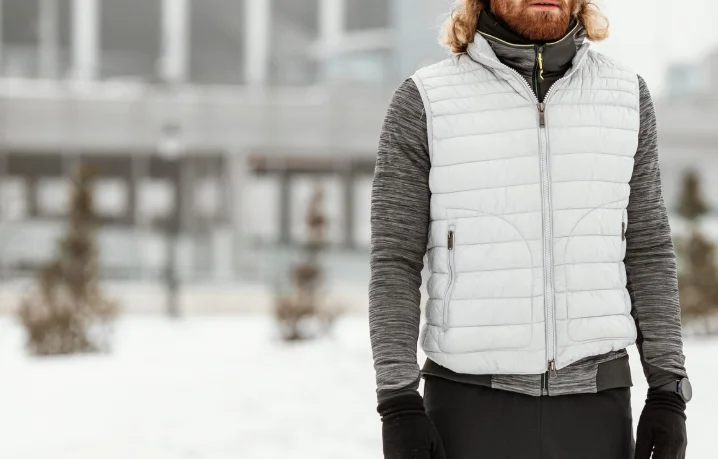Experience Winter Warmth Like Never Before
When temperatures drop, staying warm becomes a daily challenge especially if you’re always on the move. Traditional winter wear may help, but it’s often bulky and restrictive. That’s where a heated vests steps in. Designed to provide targeted warmth without adding weight, heated vests offer a high-tech, convenient solution for cold-weather comfort. Whether you’re enjoying a hike, working outdoors, or simply trying to survive the winter commute, a heated vest can transform your experience.
Unlike ordinary vests, these garments feature built-in heating elements powered by rechargeable batteries. They deliver consistent warmth to key areas like the chest, back, and neck, making them a popular choice for winter enthusiasts and everyday users alike.
How Heated Vests Work
Heated vests use flexible carbon fiber or graphene-based heating elements strategically placed inside the fabric. These zones typically cover high-impact areas such as:
Upper back
Lower back
Chest
Collar (in premium models)
The heating process begins with the press of a button. Most vests include a control button on the chest, offering 3 to 4 adjustable heat levels: low, medium, and high. Some advanced models allow you to control heat through a mobile app via Bluetooth connectivity. This gives you the power to fine-tune your warmth based on weather conditions or personal comfort.
The heat is powered by a compact lithium-ion battery, usually tucked into a zippered side or inner pocket. A single charge can last anywhere from 6 to 12 hours, depending on the heat setting.
Top Benefits of Heated Vests
1. Core Temperature Regulation
Keeping your torso warm is critical to maintaining overall body heat. A heated vest does just that by focusing heat on your core, reducing the body’s need to divert energy from extremities to stay warm. As a result, your entire body feels warmer—even your hands and feet.
2. Enhanced Comfort Without Bulk
Traditional winter jackets often restrict movement and feel heavy. Heated vests, on the other hand, are designed to be lightweight and breathable. This allows for layering under a heavier coat if needed or wearing it solo during mild cold spells.
3. Versatility in All Settings
Heated vests are not limited to winter sports. They’re ideal for:
Outdoor workers
Campers
Hikers
Hunters
Motorcyclists
Elderly individuals with poor circulation
Office workers in cold environments
No matter where you are, these vests deliver warmth without hassle.
4. Relieves Cold-Induced Health Issues
If you suffer from conditions like Raynaud’s syndrome, arthritis, or chronic back pain, heated vests can offer therapeutic benefits. The gentle warmth eases muscle tension and increases blood flow, reducing discomfort and improving mobility.
5. Cost and Energy Efficiency with Heated Vests
Instead of heating an entire room or space, simply wear your vest indoors. This not only conserves energy but also helps lower utility bills—especially during harsh winters.
Key Features to Consider Before Buying Heated Vests
1. Battery Life and Charging Time
Choose a vest with a strong battery that offers at least 8–10 hours of use on low to medium settings. Some models also offer quick charging or swappable batteries for uninterrupted use. Check the mAh rating for a clearer idea of battery performance.
2. Heating Zones
The number and placement of heating zones vary by model. Entry-level vests usually offer 2–3 zones (typically back and chest), while premium options include 4–5 zones with neck or shoulder heating.
3. Temperature Control
Look for vests with multiple heat settings. This lets you customize warmth depending on your activity level and the surrounding temperature. Some vests also include intelligent temperature sensors that automatically adjust heat output.
4. Fabric and Material
Material matters. Choose vests made from water-resistant or windproof fabric like polyester, softshell, or nylon blends. The inner lining should be soft, preferably fleece or cotton for comfort and insulation.
5. Washability
Always check if the vest is machine washable. Most are, but you must remove the battery and heating elements first. Follow the care instructions carefully to maintain performance.
6. Fit and Sizing
Heated vests should be snug to allow effective heat transfer but not so tight that they restrict movement. Some brands offer adjustable side zippers or elastic bands to help you find the perfect fit.
Best Uses for Heated Vests
1. Outdoor Work
Construction workers, delivery drivers, and utility personnel benefit from heated vests during long shifts outdoors. The continuous warmth helps maintain productivity and morale.
2. Winter Sports and Recreation
Whether you’re snowboarding, skiing, ice fishing, or hiking, a heated vest provides warmth without restricting motion. It keeps your core warm even in harsh, snowy conditions.
3. Hunting and Camping
Staying warm during early morning or overnight hunts can be tough. Heated vests keep your body temperature stable, helping you focus on the experience rather than the cold.
4. Commuting and Travel
Long waits at bus stops or train stations become easier with heated clothing. They’re also great for motorcycle and bicycle commuters exposed to the elements.
5. Everyday Indoor Use
If you work in a chilly office, warehouse, or poorly heated home, a heated vest lets you stay cozy without raising the thermostat.
Top Heated Vests Brands to Consider
1. Ororo
Highly rated for comfort and performance. Offers 4 heating zones, 3 temperature settings, and up to 10 hours of battery life. Stylish and lightweight.
2. Venture Heat
Durable, professional-grade vests with fast heat-up times and excellent temperature retention. Ideal for extreme conditions.
3. ARRIS
Unique for its adjustable sizing. Offers strong heating power and includes an extra-large battery for longer warmth.
4. TideWe
Designed for outdoor sports. These vests are water-resistant, breathable, and come with camo options for hunters.
5. PTAHDUS
Affordable yet efficient. PTAHDUS vests are easy to use, machine washable, and come with reliable heating elements.
Care and Safety Tips
Always remove the battery before washing.
Follow the brand’s cleaning instructions to avoid damaging heating wires.
Do not iron or dry clean.
Store the vest in a cool, dry place when not in use.
Recharge the battery fully after each use to extend its lifespan.
Avoid using if the vest becomes wet from rain or snow unless specified as waterproof.
Are Heated Vests Safe?
Absolutely. Heated vests are engineered with built-in safety features such as auto shut-off, temperature limiters, and short-circuit protection. As long as you follow instructions, these garments are safe for daily wear.
Conclusion: Make Winter Your Season with Heated Vests
Don’t let winter stop your adventures. Heated vests give you the freedom to enjoy the outdoors, stay productive at work, or relax at home in total warmth and comfort. With long-lasting batteries, advanced heat zones, and stylish designs, they offer unmatched performance in cold climates.
From snowy trails to frosty commutes, a heated vest is more than just clothing—it’s your personal heating system. Invest in one today and feel the difference every day of the season.
Stay warm & active. Stay unstoppable with the right heated vest.










